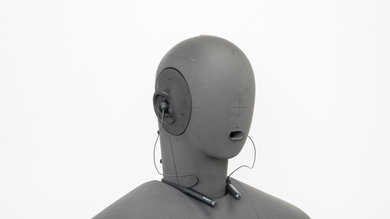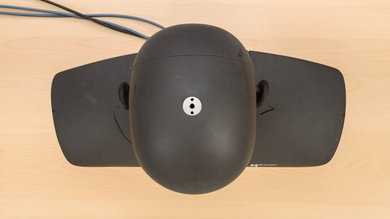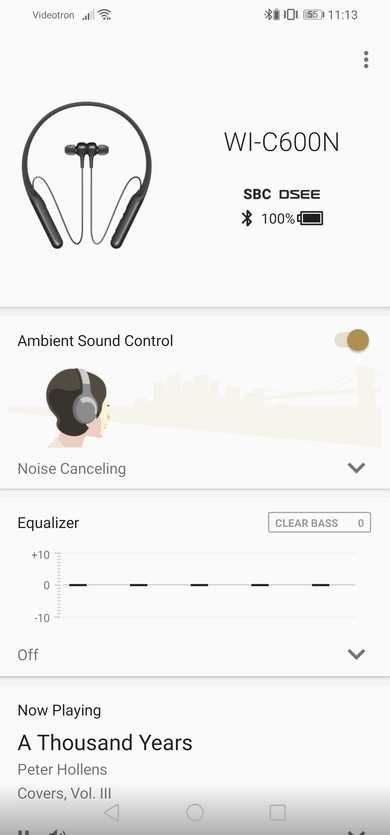The Sony WI-C600N Wireless are okay around-the-neck in-ear headphones that have a decent audio reproduction and ANC feature. They're versatile for various everyday uses, but their neckband design might not be for everyone. They also have a disappointing six-hour continuous battery life, and they take about two hours to charge. On the upside, you can use them for commuting or at the office since they block out a good amount of ambient noise, and they're compatible with the Sony mobile app, which offers plenty of customization and control options.
Our Verdict
The Sony WI-C600N are decent mixed usage in-ears. They have a decent audio reproduction that is fairly versatile for many music genres, and they have a good isolation performance, which helps block out ambient noise when commuting or at the office. They sit securely inside the ears and are very breathable thanks to their small design, making them suitable for sports. However, like most Bluetooth headphones, they won’t be ideal for watching video content and gaming due to their high latency.
- Decent audio reproduction.
- Lightweight and fairly comfortable design.
- Good isolation performance.
- Mediocre battery life.
- In-ear fit and neckband design might not be for everyone.
The Sony WI-C600N Wireless are decent for neutral sound. They have a powerful, extended, and consistent bass, a very good and well-balanced mid-range, and a good treble as well. However, they might sound a bit boomy, thick, and cluttered, which will mostly affect vocals and lead instruments. Also, their treble is slightly uneven, resulting in sibilants (S and T sounds) being overly sharp and piercing, while some may lack detail and brightness. Overall, these headphones are fairly versatile for a wide variety of music genres but will be better suited for bass-heavy music. However, the in-ear fit might not be the most comfortable for long listening sessions.
The Sony WI-C600N are decent for commuting. These wireless in-ears have a decent ANC feature that blocks out a good amount of noise, including a decent amount of deep rumbles of plane and bus engines. They also barely leak, so you can mask more noise by raising your listening volume. Also, they have a portable neckband design since the band is flexible and malleable. However, their battery life might not be long enough for long flights.
The Sony WI-C600N Wireless are good for sports. These around-the-neck headphones are fairly portable and easy to carry around, thanks to the flexible neckband design. They sit nicely inside the ears and don’t pop out easily, suitable for most sports. However, some may not like the neckband design when jogging. On the upside, they're lightweight, and the buds are very small, meaning they won’t make you sweat more than usual when using them.
The Sony WI-C600N are okay for the office. The Sony WI-C600N do a good job at blocking out work environment noise like ambient chatter and A/C system noise. They also don’t leak, so surrounding colleagues shouldn’t hear what you’re listening to, even at higher volumes. Unfortunately, they don’t support multi-device pairing, so you can't switch between sources like your PC and phone, and their battery life might not be long enough for a full workday.
The Sony WI-C600N aren't suitable for wireless gaming. Their microphone won’t be suitable for online games, and their battery life won’t be long enough for long gaming sessions. Also, like most Bluetooth headphones, they have latency issues that will make your gaming experience frustrating as there will be a noticeable delay between audio and video.
Changelog
- Updated Jul 15, 2020: We have updated the charging cable type.
- Updated Mar 27, 2020: Converted to Test Bench 1.4.
- Updated Nov 21, 2019: Converted to Test Bench 1.3.1.
- Updated Nov 21, 2019: Converted to Test Bench 1.3.
Check Price
Popular Headphones Comparisons

The Sony WI-C600N Wireless are around-the-neck headphones that are kind of an in-between of the Sony WI-C400 and the Sony WI-1000X. They have a good isolation performance and a malleable, flexible neckband. However, their battery life is fairly short and their design might not be for everyone.
See our recommendation for best neckband headphones, the best earbuds and in-ear headphones, and the best noise cancelling earbuds.
The Sony WI-C600N Wireless are noise cancelling in-ears, but the Beats BeatsX Wireless actually block out more noise passively. The Beats also feel more secure inside the ears, which is better for sports. Their neckband design is quite similar and malleable. Sound-wise, they are quite similar, but you can EQ the Sonys inside their app, which the Beats are lacking. On the other hand, the Beats take a very short amount of time to fully charge and could have better performance with iOS devices thanks to the W1 chip.
The Sony WI-C600N Wireless are better around-the-neck headphones than the Sennheiser Momentum In-Ear Wireless. They are more portable thanks to their malleable neckband and their sound quality is also better, but you can EQ both headphones in their respective apps. They're also noise cancelling in-ears and block a decent amount of ambient noise, which is good for commuting. On the other hand, you get more battery life with the Sennheisers, their latency is lower, and some may not notice the delay when watching video content.
The Jabra Elite 65e Wireless are slightly better headphones than the Sony WI-C600N Sony C600N. Their earbud fit is more comfortable than the typical in-ear design of the Sonys. They also feel noticeably better-built and more durable. The ANC feature of the Elite 65e is also slightly better, and their microphone is noticeably clearer and better for calls. Additionally, you get more battery life with the Jabra. On the other hand, the Sony WI-C600N have a slightly better app and their default sound profile is better, although you can EQ both headphones to your liking. The Sony headphones also support NFC, but can’t connect to two devices like the Jabra.
The Sony WI-C600N Sony C600N and the Sony WI-1000X Wireless are similarly performing headphones, but the ANC feature of the WI-1000X make them a more versatile pair of headphones. Their sound profiles are practically the same, but the WI-1000X are good for commuting as it blocks noticeably more low-end frequencies. They also have more battery life, can connect to two devices simultaneously, and can also be used passively with an audio cable, even if their battery is dead. They also have a rigid neckband that feels sturdier than the WI-C600N but isn’t as flexible.
Test Results

The Sony C600N are around-the-neck headphones that look fairly similar to the Sony WI-1000X Wireless, but with a slightly cheaper feel. They don’t stand out very much, and they come in three different color schemes: black, blue, or grey. The neckband is fairly flexible and malleable, but the cables are very thin and look fragile.
The Sony WI-C600N are decently comfortable in-ears. They're very lightweight and don’t apply too much pressure inside your ears, but some may still not find the in-ear fit to be comfortable. Also, the neckband is lightweight, but not everyone will like having something around their neck. They come with four tip options to help you find the best possible fit, but they aren’t as comfortable as the Bose QuietControl 30/QC30 Wireless.
The Sony WI-C600N's control scheme offers common functionalities, but the small size of the buttons and the rubber coating makes it a bit hard to press them. On the left side of the neckband, you get a call/music management button, a volume rocker, and the power button. The play/pause button also acts as a track skipper with multi-presses. On the right side, you have the ANC control button that lets you cycle between ANC on, ambient mode enabled, and ambient mode disabled. You can also map that button inside the app to trigger Google Assistant (not available with other voice assistants).
Like most in-ear headphones, these Sony WI-C600N are very breathable as they don’t trap heat against your ears and allow a good amount of airflow. You shouldn’t sweat more than usual when wearing these during physical activity and won’t notice a big difference in temperature during casual listening sessions.
The Sony C600N are quite portable. Their neckband design takes more space than a typical wireless in-ear design, but it's malleable and flexible. You could fit them in large pockets or a bag and bring them around. Also, their design is easy to carry around your neck at all times, which makes them a bit more portable than over-ear headphones. Unfortunately, they don’t come with a pouch or a case to protect them.
The Sony WI-C600N Wireless headphones don’t have a case or pouch.
The Sony C600N are decently well-built but don’t feel as solid as the Sony WI-1000X Wireless. The neckband is malleable and won’t snap under physical stress, which is good. However, the cables are very thin and don’t feel very durable. On the upside, they don’t feel as cheaply made as the Sony WI-C400 Wireless. The buds are also magnetic, which helps with cable management.
The Sony WI-C600N are stable inside the ears and don’t move too much, thanks to their very small design. They sit nicely, but not everyone will like jogging or doing physical activity with a neckband. The buds feel secure, but a light tug on the cable can make them pop out. On the upside, since they're wireless, you don’t have to worry about any cable being in your way or getting hooked on something, yanking the headphones out.
They have fantastic frequency response consistency. Assuming the user can achieve a proper fit and an air-tight seal using the assortment of tips that come with the headphones, they should get consistent bass and treble delivery every time they use the headphones.
The Sony C600N's bass accuracy is excellent. Their LFE (low-frequency extension) is down to 12Hz, which is excellent. This and their very accurate low-bass means they can reproduce the right amount of thump and rumble common to bass-heavy genres. Unfortunately, there’s a 2.5dB overemphasis in high-bass, which will result in a bass that sounds slightly boomy and muddy.
These headphones have great mid-range accuracy. The response throughout the range is very close to our target curve, but there is a bump in low-mid, which is the continuation of the high-bass overemphasis. This will result in vocals and lead instruments sounding a bit thick and cluttered.
The Sony WI-C600N have decent treble accuracy. There’s a shallow but broad dip under 6kHz that will negatively affect the brightness and detail of vocals and leads. Also, after the 6kHz region, the response is fairly uneven, meaning that some sibilants (S and T sounds) will lack detail while others might feel overly sharp and piercing on already bright tracks. However, not everyone hears the treble frequencies the same way, so your listening experience may vary.
These headphones have an incredible imaging performance. The weighted group delay is at 0.17, which is very good. The GD graph also shows that the entire group delay response is below the audibility threshold, suggesting a tight bass reproduction and a transparent treble. Additionally, the L/R drivers of our test unit were well-matched in amplitude, frequency, and phase response, which is important for the accurate placement and localization of objects (voices, instruments, video game effects) in the stereo image. However, these results are only valid for our unit, and yours may perform differently.
The Sony WI-C600N's passive soundstage is bad. Since creating a large and speaker-like soundstage is partially dependent on having a speaker-like pinna activation, and in-ear headphones bypass the pinna (the outer ear) and don't interact with it, their soundstage will be perceived to be small and located inside the listener's head. Their closed-back design also means that their soundstage won't feel and open as open-back earbuds like the Apple AirPods (2nd generation) Truly Wireless and the Bose SoundSport Free Truly Wireless.
The Sony WI-C600N have a good noise isolation performance. With their ANC (active noise cancelling) enabled, these in-ears achieved about 12dB of isolation in the bass range, which is decent. This means they can cancel out the low rumbling noises like airplane and bus engines to a good degree. However, there seems to be a weak point around 250Hz. In the mid-range, important for blocking out speech, they isolate by 18dB, which is also good. In the treble range, occupied by sharp sounds like S and Ts and air conditioning systems, they achieved 31dB of isolation, which is good. However, it seems the noise isolation gets worse once the ANC is enabled, but this won't be very audible.
Like most other in-ear headphones, these headphones don't leak very much audio. A significant portion of the leakage is in a narrow range in the treble between 2kHz and 4kHz. This means that the leakage will be thin and mostly consist of sharp sounds. The overall level of the leakage is not very loud either. With the music at 100dB SPL, the leakage averages at 28dB SPL and peaks at around 44dB SPL at 1 foot away, which is below the noise floor of most offices.
The integrated microphone's recording quality is mediocre. LFE (low-frequency extension) is at 65Hz, which is good, but the graph shows that there’s a bump centered around 100Hz, which means the mic will be sensible to pops and rumbling noises. The dip around 150Hz means transmitted/recorded speech with this mic will sound noticeably thin. The HFE (high-frequency extension) of 2.5kHz indicates speech that lacks detail and is noticeably muffled. Speech will still be decently intelligible with this microphone in very quiet environments.
The microphone's noise handling is mediocre. In our SpNR test, it achieved a speech-to-noise ratio of 15dB, meaning it's best suited for quiet environments since it'll struggle to fully separate speech from ambient noise, even in moderately loud situations like a busy street.
The Sony WI-C600N's battery life is about 6 hours of continuous playback on one charge, which is slightly disappointing. You can also get up to 7.5 hours without their ANC enabled, according to Sony. Also, they take two hours to charge fully, which is quite long for the amount of playback time you get. On the upside, there's an auto-off feature that turns the headphones off automatically when they aren't connected to a device. Ηowever, they stay on as long as they're connected to a device, even if no audio is playing, so this isn't considered a power-saving feature.
The Sony WI-C600N are compatible with the Sony | Headphones Connect app. You can customize the sound to your liking, thanks to a graphic equalizer and presets. You can also adjust the amount of noise cancellation between the available settings. The app is well designed, easy to use, and offers a playback player, and lets you map the ANC button to trigger Google Assistant (but it doesn't work with other voice assistants).
These headphones are Bluetooth compatible, and like most Sony headphones, they support NFC for quicker and easier pairing. Unfortunately, they can’t be connected to multiple devices at the same time, which would have been useful at the office if you often switch between your work computer and your phone.
The Sony WI-C600N headphones have somewhat high latency with PCs and iOS devices, so some may notice a small delay between audio and video. They have slightly lower latency when using the aptX codec with PCs, but most won’t notice the difference in that regard. On the plus side, they have lower latency with Android devices.
You can't use these around-the-neck headphones passively with an audio cable like the Sony WI-1000X.















